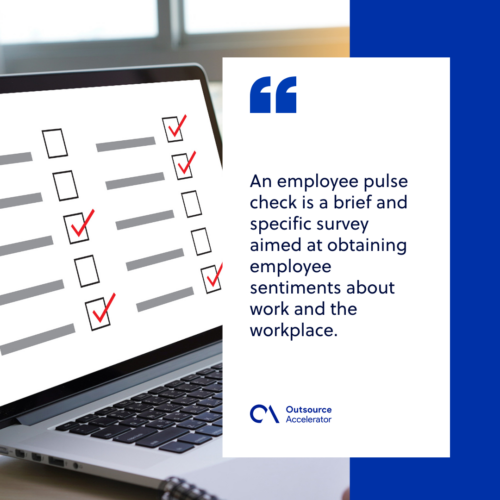Employee pulse check
Definition
What is an employee pulse check?
An employee pulse check is a brief and specific survey aimed at obtaining employee sentiments about work and the workplace. It says a lot about the company’s culture as a whole.
This survey is often sent out and changed once a week. This guarantees that you receive the most accurate response and collect the most data.
Since this survey is brief and specific, participation rates are significantly greater than the other types of surveys.
How to conduct an employee pulse check
Employee pulse checks are designed to be quick, simple, and insightful. You’re not looking for a complete employee interview; it’s just an HR tool to assist you in getting a brief idea of how your staff is thinking.
While employee pulse checks should be quick, they should not be ineffective.
Employees’ answers will stay anonymous – so this is the management’s chance to ask any questions they have about business policies, corporate culture, and the overall workplace environment.
Companies should do an employee pulse check so that workers can express their thoughts or make suggestions.
Using employee pulse checks relieves your staff of the stress of causing unpleasant circumstances and allows the employer to obtain honest feedback from the survey.

What are the benefits of conducting an employee pulse check?
Here are some of the benefits of conducting an employee pulse check:
Real-time data
Capturing an employee’s pulse through pulse survey software is much better than conducting a detailed employee engagement survey.
It also helps prevent survey fatigue and provides you with updated information on how your employees view the company’s culture. This enables you to address areas of concern while moving and can significantly improve your company’s cultural practices.
When an employee is unsatisfied with anything, finding out about it immediately through an employee survey rather than waiting months for a suppressed answer is preferable.
Improved employee attitude
Employees appreciate when they are heard. It inspires them to do better and be productive. In the long run, this can increase the possibility of your best employees staying with the organization.
Regular employee pulse surveys, complete with relevant pulse survey questions, can help increase employee satisfaction and ensure their voices are consistently heard.
Creates an environment for open communication
When your employees feel that their opinion matters, they are more likely to speak out, building a culture of free and open internal communication.
Employees need to interact with management as this establishes a platform for continuous feedback and performance evaluation.
Employee engagement
You can use the data collected to conduct engagement initiatives that are specific to your areas of concern. Further, employees tend to offer feedback on every job or event in the firm, which keeps them focused and involved with everything that happens in the organization.
6 steps to a successful employee pulse survey
Here are the six steps to a successful employee pulse survey:
1. Choose the questions you will ask
You should select four to ten questions that cover various topics, such as satisfaction, motivation, emotions about management, workload, and work-life balance. Ensure that the questions aren’t misleading or too confusing to answer.
Then, properly plan and distribute your pulse surveys to the organization to guarantee a high response rate. This is best communicated through an organization-wide email from the management or as a topic of discussion at your next meeting.
2. Start the survey
Consider how frequently you will survey employees and the best day and time to do so before conducting the initial survey.
Doing surveys at the start of the workweek and during the weekend is not ideal. Most businesses send surveys mid-week to get a stronger understanding of what the atmosphere is like in the workplace.
3. Analyze the responses
Make it a practice to review all the feedback in detail and search for common areas of concern for the next pulse survey.
The worst action a manager will take is to completely disregard the results of the survey. In this case, it is preferable not to execute them than to require employees to complete them just to disregard their opinions and suggestions.

4. Share the survey
Many businesses share survey results with the entire team, whereas others only share the information with immediate superiors or the management team.
It is crucial to communicate positive and negative responses, even if we consider all feedback to be positive in purpose.
5. Take action
Taking action is the most crucial part when surveying since this will be the time employees will feel they are heard. If you gather employee feedback and do nothing about it, you are not asking for opinions and are open to changes.
It is disappointing for employees who invest time in responding to surveys to find that nothing takes place, and this often makes employees feel neglected and unvalued.
6. Review and repeat
Continue gathering pulse surveys and see the effect of your actions before you have made it to the team.
Keep in mind that regularly conducting complete pulse surveys at a consistent survey frequency allows for an effective employee pulse check to gauge and improve organizational engagement.
This will give valuable insights to the management on how to treat each employee and how they will run the company accordingly.







 Independent
Independent




